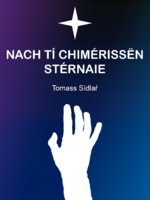IIWiki:Today's featured article: Difference between revisions
(July 2023 Update) |
(August 2023 Update) |
||
| Line 1: | Line 1: | ||
<div style="float:left;margin:0.5em 0.9em 0.4em 0;">[[File: | <div style="float:left;margin:0.5em 0.9em 0.4em 0;">[[File:Following_the_Chimeric_Star_cover.png|150px]]</div> '''''Following the Chimeric Star''''' ([[Walnerian language|Walnerian]]: ''Nach tí Chimérissën Stérnaie'') is a 1988 [[wikipedia:Novel|novel]] written by the [[Walneria|Walnerian]] [[wikipedia:Screenwriting|screenwriter]] and [[wikipedia:Journalist|journalist]] Tomass Sídlaŕ. It is written using the [[wikipedia:First-person narrative|first-person narrative]] mixed with few moments, where the [[wikipedia:Narration#Third-person|third person omniscient subjective]] is used. It is set in the "present day", as no year is mentioned and the book is kept vague to make it feel like it may be happening at any time. The illustrations, always using a dark blue - purple gradient with white silhouettes on it, were drawn by the author's brother Jakov Sídlaŕ. The main character is 19-year-old student Petŕ Junek, who is seeking a refuge from the stress of school with a female character referred to only as "Star". Star is a young woman which is described only in metaphors, at least through the eyes of Petŕ. Minor characters of the story are Petŕ's father (who remains unnamed), Petŕ's teacher (who also remains unnamed) and Petŕ's two friends (who are referred to only by nicknames Kurys and Globi, however, Kurys's surname was mentioned to be "Kuriáss"). ('''[[Following the Chimeric Star|See more...]]''') | ||
<div align="right"> | <div align="right"> | ||
Revision as of 20:42, 6 August 2023
Following the Chimeric Star (Walnerian: Nach tí Chimérissën Stérnaie) is a 1988 novel written by the Walnerian screenwriter and journalist Tomass Sídlaŕ. It is written using the first-person narrative mixed with few moments, where the third person omniscient subjective is used. It is set in the "present day", as no year is mentioned and the book is kept vague to make it feel like it may be happening at any time. The illustrations, always using a dark blue - purple gradient with white silhouettes on it, were drawn by the author's brother Jakov Sídlaŕ. The main character is 19-year-old student Petŕ Junek, who is seeking a refuge from the stress of school with a female character referred to only as "Star". Star is a young woman which is described only in metaphors, at least through the eyes of Petŕ. Minor characters of the story are Petŕ's father (who remains unnamed), Petŕ's teacher (who also remains unnamed) and Petŕ's two friends (who are referred to only by nicknames Kurys and Globi, however, Kurys's surname was mentioned to be "Kuriáss"). (See more...)
KEEP THIS ONE PARAGRAPH IN LENGTH so it doesn't push the main page section down below the other section.
